Related Research Articles
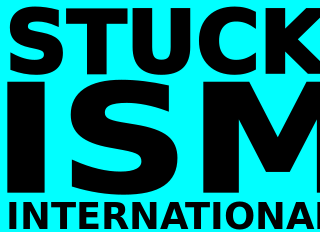
Stuckism is an international art movement founded in 1999 by Billy Childish and Charles Thomson to promote figurative painting as opposed to conceptual art. By May 2017 the initial group of 13 British artists had expanded to 236 groups in 52 countries.

The Turner Prize, named after the English painter J. M. W. Turner, is an annual prize presented to a British visual artist. Between 1991 and 2016, only artists under the age of 50 were eligible. Awarding the prize is organised by the Tate gallery and usually staged at Tate Britain, though in recent years the award ceremony has sometimes been held in other UK cities. Since its beginnings in 1984 it has become the UK's most publicised art award. The award represents all media.

The Young British Artists, or YBAs—also referred to as Brit artists and Britart—is a loose group of visual artists who first began to exhibit together in London in 1988. Many of the first generation of YBA artists graduated from the BA Fine Art course at Goldsmiths, in the late 1980s, while the second generation mostly came from the Royal College of Art.

Damien Steven Hirst is an English artist, entrepreneur, and art collector. He is one of the Young British Artists (YBAs), who dominated the art scene in the UK during the 1990s. He is reportedly the United Kingdom's richest living artist, with his wealth estimated at $384 million in the 2020 Sunday Times Rich List. During the 1990s his career was closely linked with the collector Charles Saatchi, but increasing frictions came to a head in 2003 and the relationship ended.

The Saatchi Gallery is a London gallery for contemporary art, opened by Charles Saatchi in 1985 in order to exhibit his collection to the public. It has occupied different premises, first in North London, then the South Bank by the River Thames, and finally in Chelsea, its current location. Charles Saatchi's collection—and hence the gallery's shows—has had distinct phases, starting with US artists and minimalism, moving to the Damien Hirst-led Young British Artists, followed by shows purely of painting, and then returning to contemporary art from America in USA Today at the Royal Academy in London. A 2008 exhibition of contemporary Chinese art formed the inaugural exhibition in the new venue for the gallery at the Duke of York's HQ.

Sir Nicholas Andrew Serota, is an English art historian and curator, who served as the Director of the Tate from 1988 to 2017. He is currently Chair of Arts Council England, a role which he has held since February 2017.

Charles Thomson is an English artist, poet and photographer. In the early 1980s he was a member of The Medway Poets. In 1999 he named and co-founded the Stuckists art movement with Billy Childish. He has curated Stuckist shows, organised demonstrations against the Turner Prize, run an art gallery, stood for parliament and reported Charles Saatchi to the OFT. He is frequently quoted in the media as an opponent of conceptual art. He was briefly married to artist Stella Vine.

The Stuckists Punk Victorian was the first national gallery exhibition of Stuckist art. It was held at the Walker Art Gallery and Lady Lever Art Gallery in Liverpool from 18 September 2004 to 20 February 2005 and was part of the 2004 Liverpool Biennial.
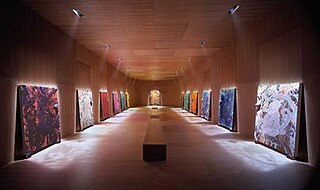
The Upper Room is an installation of 13 paintings of rhesus macaque monkeys by English artist Chris Ofili in a specially-designed room. It was bought by the Tate gallery in 2005 from the Victoria Miro Gallery and was the cause of a media furore after a campaign initiated by the Stuckist art group as Ofili was on the board of Tate trustees at the time of the purchase. In 2006 the Charity Commission censured the Tate for the purchase, but did not revoke it.
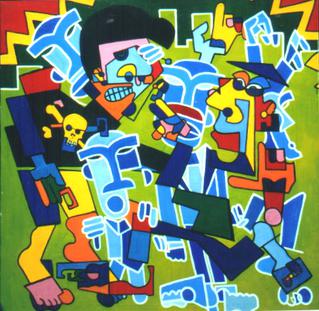
Stuckism is an art movement that began in London, England, in 1999. In 2000, Melbourne artist Regan Tamanui started the first international branch of the movement. As of 2010, there are seven Australian Stuckist groups, who have held shows—sometimes concurrently with UK activities—received coverage in the Australian press and on TV, and also been represented in UK shows. The Stuckists take a strong pro-painting and anti-conceptual art stance, and were co-founded by Charles Thomson and Billy Childish.
Louisa Buck is a British art critic and contemporary art correspondent for The Art Newspaper. She was a jurist for the 2005 Turner Prize. She is also an author or co-author of books on contemporary art market.

Mark D, born Mark Randall, is a British punk musician. He is also associated with the Stuckist group of artists. Mark D was born and spent his childhood in Peterborough. He now lives in Nottingham.

Stuckist demonstrations since 2000 have been a key part of the Stuckist art group's activities and have succeeded in giving them a high-profile both in Britain and abroad. Their primary agenda is the promotion of painting and opposition to conceptual art.
Sarah Kent is a British art critic, formerly art editor of the weekly London 'what's on' guide Time Out. She was an early supporter of the Young British Artists in general, and Tracey Emin in particular, helping her to get early exposure. This has led to polarised reactions of praise and opposition for Kent. She adopts a feminist stance and has stated her position to be that of "a spokesperson, especially for women artists, in a country that is essentially hostile to contemporary art."
Jim Shaw is a contemporary American artist.
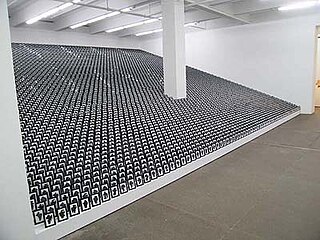
Neo-conceptual art describes art practices in the 1980s and particularly 1990s to date that derive from the conceptual art movement of the 1960s and 1970s. These subsequent initiatives have included the Moscow Conceptualists, United States neo-conceptualists such as Sherrie Levine and the Young British Artists, notably Damien Hirst and Tracey Emin in the United Kingdom, where there is also a Stuckism counter-movement and criticism from the 1970s conceptual art group Art and Language.
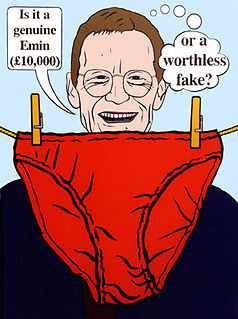
Sir Nicholas Serota Makes an Acquisitions Decision is one of the best known paintings to come out of the Stuckism art movement, and a likely "signature piece" for the movement, standing for its opposition to conceptual art. It was painted by the Stuckism co-founder Charles Thomson in 2000, and has been exhibited in a number of shows since, as well as being featured on placards during Stuckist demonstrations against the Turner Prize.

The Stuckism International Gallery was the gallery of the Stuckist art movement. It was open from 2002 to 2005 in Shoreditch, and was run by Charles Thomson, the co-founder of Stuckism. It was launched by a procession carrying a coffin marked "The death of conceptual art" to the neighbouring White Cube gallery.

Everyone I Have Ever Slept With 1963–1995 (1995), also known as The Tent, was an artwork by Tracey Emin. The work was a tent with the appliquéd names of, literally, everyone she had ever slept with. It achieved iconic status and was owned by Charles Saatchi. Since its destruction in the 2004 Momart London warehouse fire, Emin has refused to recreate the piece.
Gregor Muir is Director of Collection, International Art, at Tate, having previously been the Executive Director of the Institute of Contemporary Arts in London from 2011 until 2016. He was previously director of the commercial art gallery Hauser & Wirth, in London. He is author of the 2009 memoir Lucky Kunst, in which he recalls experiences in the YBA art scene and life in 1990s London.
References
- ↑ "Adrian Searle - University of the Arts London". Archived from the original on 22 December 2012.
- ↑ Milliard, Coline. ""He Still Walks Beside Me:" Art Critic Adrian Searle on Curating the Work of his Late Friend Juan Muñoz". Blouin Art Info. Retrieved 1 February 2014.
- ↑ Buck, Louisa (2000). Moving Targets 2: A User's Guide to British Art Now. London: Tate Gallery Publishing. ISBN 1-85437-316-1
- ↑ "What the Critics Say – Jim Shaw at the ICA" Archived 25 October 2006 at the Wayback Machine , newsletter 2, artrumour.com, 23 October 2000. Retrieved 28 March 2006.
- ↑ "Monkey Magic", The Guardian, 25 June 2002. Retrieved 21 March 2006.
- ↑ "Same Again Saatchi" Archived 30 March 2006 at the Wayback Machine , The Guardian, 23 March 2004. Retrieved 21 March 2006.
- ↑ "Scouse Stew" Archived 7 September 2008 at the Wayback Machine , The Guardian, 21 September 2004. Retrieved 21 March 2006.
- ↑ "Is Damien Hirst the Most Powerful Person in Art?" Archived 26 June 2008 at the Wayback Machine , The Guardian, 1 November 2005. Retrieved 21 March 2006.
- ↑ "Tracey Emin", The Guardian, 27 May 2005. Retrieved 21 March 2006.